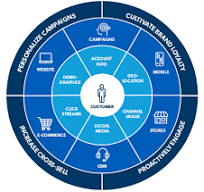The Power of System Integration Solutions
In today’s fast-paced business environment, organizations are constantly seeking ways to streamline their operations, enhance efficiency, and improve overall performance. One key strategy that has emerged as a game-changer is system integration.
System integration involves combining different subsystems or components into one comprehensive system that functions seamlessly together. This approach allows businesses to connect disparate systems, applications, and processes to create a unified and efficient infrastructure.
Benefits of System Integration Solutions
Improved Efficiency: By integrating various systems and applications, businesses can automate processes, reduce manual intervention, and minimize errors. This leads to improved operational efficiency and productivity.
Enhanced Data Accuracy: System integration ensures that data is shared accurately and consistently across different platforms. This results in better decision-making based on real-time information.
Cost Savings: By streamlining processes and eliminating duplicate efforts, system integration solutions help businesses save on costs associated with manual tasks and inefficiencies.
Challenges of System Integration
While the benefits of system integration are significant, implementing such solutions can pose challenges. Compatibility issues between different systems, data security concerns, and the complexity of integration processes are some common obstacles businesses may face.
Choosing the Right System Integration Partner
Given the complexities involved in system integration, it is crucial for businesses to partner with experienced professionals who specialize in providing tailored solutions. A reliable system integration partner can assess your organization’s needs, design a customized integration plan, and ensure seamless implementation.
Conclusion
System integration solutions have become indispensable for modern businesses looking to stay competitive in today’s digital landscape. By harnessing the power of integrated systems, organizations can achieve operational excellence, drive innovation, and deliver enhanced value to their customers.
Unlocking Business Potential: 6 Benefits of System Integration Solutions
- Enhanced operational efficiency
- Improved data accuracy
- Cost savings through automation
- Streamlined business processes
- Seamless information sharing
- Increased productivity and performance
Top 7 Challenges of System Integration Solutions: What to Watch Out For
- Complexity of implementation process
- Potential for compatibility issues between different systems
- Risk of data security breaches during integration
- Costly investment in system integration solutions
- Need for specialized expertise to manage and maintain integrated systems
- Disruption to existing workflows during the integration process
- Difficulty in ensuring seamless communication and data exchange between integrated systems
Enhanced operational efficiency
Enhanced operational efficiency is a key advantage of system integration solutions. By seamlessly connecting different systems and automating processes, businesses can streamline their operations, reduce manual tasks, and eliminate redundancies. This leads to smoother workflows, improved productivity, and cost savings. With enhanced operational efficiency, organizations can focus on strategic initiatives, drive innovation, and deliver better results to their customers.
Improved data accuracy
Improved data accuracy is a key advantage of system integration solutions. By ensuring that data is shared accurately and consistently across different systems and applications, businesses can make informed decisions based on reliable and up-to-date information. This leads to greater confidence in the data-driven insights generated by the integrated systems, ultimately enhancing overall operational efficiency and driving better business outcomes.
Cost savings through automation
Cost savings through automation is a significant advantage of system integration solutions. By automating processes and eliminating manual tasks, businesses can reduce operational costs associated with labor, errors, and inefficiencies. Automation streamlines workflows, improves productivity, and allows employees to focus on more strategic tasks that add value to the organization. Ultimately, cost savings through automation not only enhances the bottom line but also drives overall efficiency and competitiveness in today’s dynamic business landscape.
Streamlined business processes
System integration solutions offer the significant advantage of streamlined business processes. By integrating various systems and applications into a cohesive infrastructure, businesses can automate workflows, eliminate manual tasks, and ensure seamless data flow across different departments. This streamlining of processes not only enhances operational efficiency but also reduces errors, accelerates decision-making, and ultimately improves overall productivity within the organization.
Seamless information sharing
Seamless information sharing is a key advantage of system integration solutions, enabling organizations to break down data silos and facilitate smooth communication between different systems and departments. By ensuring that data flows seamlessly across the integrated systems, businesses can make informed decisions based on real-time, accurate information. This enhanced connectivity not only boosts operational efficiency but also fosters collaboration and synergy within the organization, ultimately leading to improved productivity and better outcomes.
Increased productivity and performance
System integration solutions offer the significant benefit of increased productivity and performance for businesses. By seamlessly connecting and automating various systems and processes, organizations can streamline their operations, eliminate redundant tasks, and enhance overall efficiency. This improved productivity allows employees to focus on more strategic tasks, leading to higher output levels and better performance across the board. Additionally, integrated systems provide real-time access to accurate data, enabling faster decision-making and empowering businesses to respond swiftly to market changes and opportunities.
Complexity of implementation process
The complexity of the implementation process is a significant drawback of system integration solutions. Integrating different systems and applications often requires meticulous planning, thorough testing, and coordination among various stakeholders. The intricate nature of the integration process can lead to delays, unexpected challenges, and increased costs. Additionally, ensuring compatibility between existing systems and new integrations can be a daunting task, requiring specialized expertise and resources. Overcoming the complexities of implementation demands careful attention to detail and a strategic approach to minimize disruptions to business operations.
Potential for compatibility issues between different systems
One significant drawback of system integration solutions is the potential for compatibility issues between different systems. When integrating diverse technologies and platforms, there is a risk of incompatibility that can lead to data inconsistencies, process inefficiencies, and system malfunctions. Resolving compatibility issues requires careful planning, testing, and ongoing maintenance to ensure seamless communication and interoperability among integrated systems. Failure to address these compatibility challenges can result in disruptions to business operations and hinder the overall effectiveness of the integration efforts.
Risk of data security breaches during integration
One significant drawback of system integration solutions is the heightened risk of data security breaches during the integration process. When different systems are interconnected, there is a potential vulnerability that malicious actors could exploit to gain unauthorized access to sensitive information. Ensuring robust security measures, such as encryption protocols, access controls, and regular security audits, is essential to mitigate this risk and safeguard the integrity and confidentiality of data throughout the integration journey.
Costly investment in system integration solutions
One significant drawback of system integration solutions is the substantial initial investment required to implement and maintain integrated systems. The costs associated with integrating various subsystems, upgrading existing infrastructure, training staff on new technologies, and ongoing maintenance can be a significant financial burden for organizations. This financial commitment may deter some businesses from pursuing system integration, especially smaller enterprises with limited budgets. Additionally, unforeseen expenses or budget overruns during the integration process can further strain financial resources, making cost-effectiveness a critical consideration when evaluating system integration solutions.
Need for specialized expertise to manage and maintain integrated systems
One significant drawback of system integration solutions is the requirement for specialized expertise to effectively manage and maintain integrated systems. Implementing and sustaining integrated systems demands a high level of technical knowledge and experience in handling complex configurations, troubleshooting interoperability issues, and ensuring seamless communication between different components. Without the necessary expertise, organizations may face challenges in optimizing system performance, resolving integration-related issues promptly, and adapting to evolving technological requirements, thereby increasing the risk of operational disruptions and inefficiencies.
Disruption to existing workflows during the integration process
During the integration process, one significant con of system integration solutions is the disruption to existing workflows within an organization. Implementing system integration often requires changes to established processes and systems, which can lead to temporary inefficiencies and challenges as employees adapt to new ways of working. The transition period may result in productivity dips, increased errors, and resistance from staff members accustomed to familiar workflows. Managing this disruption effectively through proper planning, communication, and training is crucial to minimizing the impact on daily operations and ensuring a smooth integration process.
Difficulty in ensuring seamless communication and data exchange between integrated systems
One significant challenge of system integration solutions is the difficulty in ensuring seamless communication and data exchange between integrated systems. Different systems often use diverse data formats, protocols, and structures, making it complex to establish a unified communication framework. This can lead to data inconsistencies, delays in information transfer, and potential errors in data exchange processes. Overcoming this hurdle requires meticulous planning, robust integration strategies, and continuous monitoring to maintain smooth communication flow and accurate data synchronization across integrated systems.



